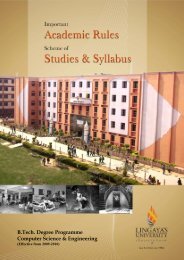Electrical and Electronics - Lingaya's University
Electrical and Electronics - Lingaya's University
Electrical and Electronics - Lingaya's University
You also want an ePaper? Increase the reach of your titles
YUMPU automatically turns print PDFs into web optimized ePapers that Google loves.
B.Tech. <strong>Electrical</strong> & <strong>Electronics</strong> Engineering (Regular)behavior of M/M/1 <strong>and</strong> M/M/C queues-the problemof machine interference <strong>and</strong> use of finite queuingtables- introduction to M/G/1, <strong>and</strong> G/M/1 .inventorycontrol problem; Concept of inventory <strong>and</strong> variouscosts; EQQ formula newspaper boy problems.6. PERT/CPM: Introduction to network analysis;Definition of a project; job <strong>and</strong> events; drawing ofarrow diagrams; determination of critical paths <strong>and</strong>calculation o floats; resource allocation <strong>and</strong> leastcost planning; use of network flows for least costplanning; uncertain duration <strong>and</strong> PERT.7. STOCHASTIC PROGRAMMING: Stochasticprogramming with one objective function;stochastic linear programming; two stageprogramming technique; chance constrainedprogramming technique.TEXT BOOKTaha H. A., "Operations Research: An Introduction",Macmillan, N.Y.REFERENCE BOOK1. Hitter F. S. <strong>and</strong> Lieberman G. J., ―Introduction toOperations Research", Addison Wesley.2. Hadley G., ―Linear Programming", Addison Wesley.3. Dantzig G., ―Linear Programming <strong>and</strong> Extensions",Princeton, N.J.4. Fletcher R., "Practical Methods of ConstrainedOptimization", John Wiley.5. Bazaraa M. S., Jervis J. J. <strong>and</strong> Sherali H. D., ―LinearProgramming & Network Flows", John Wiiey.ME-442ERGONOMICSL T P Cr5 0 0 3OBJECTIVEThe course provides knowledge of ergonomicsprinciples so that the students are able to visualizefactors which affect the efficiency of human beings.After the study of the subject, the students will be ableto select a proper design of display controls,equipment, work plan <strong>and</strong> environment1. INTRODUCTION: Definition of ergonomics <strong>and</strong>ergonomist; social <strong>and</strong> economic values ofergonomics; general <strong>and</strong> individual ergonomics.2. POSTURE AND MOVEMENT: Biomechanical;physiological <strong>and</strong> anthropometric background;postures; sitting <strong>and</strong> st<strong>and</strong>ing; Movement – lifting;carrying; pulling <strong>and</strong> pushing; Workplace design<strong>and</strong> assessment.3. INFORMATION AND OPERATION: User;information – visual; hearing <strong>and</strong> other senses;Control for operation – fixed <strong>and</strong> others diaguesuser friendliness; different forms <strong>and</strong> help; Websitedesign; mobile interaction; virtual reality.4. ENVIRONMENTAL FACTORS: Noise reduction;hearing conservation; Vibration prevention;illumination – light intensity; brightness differences;colour of light; Climate – heat <strong>and</strong> cold; Chemicalsubstances – measures; ventilation.5. WORK ORGANISATION JOBS & TASKS: Tasks;jobs; work organization – flexible; autonomousgroups; coaching measurement styles.6. ERGONOMIC APPROACH: Project management– initiative phase; problem identification phase;selection of solution phase; implementation phase;evaluation phase.7. CASE STUDIES: A set of case studies will beused to demonstrate how ergonomics had lead tochanges in work activity; safety <strong>and</strong> productdesign; Case studies will include advancedcomputer application; work place assessment;accidents; analysis <strong>and</strong> industrial inspection.TEXT BOOKJan Dul <strong>and</strong> Bernard Weerdancester, ―Ergonomics forBeginners‖, CRC Press/Taylor <strong>and</strong> Francis GroupREFERENCE BOOKS1. Knoz Stephana, Johnson Steven, Halconts ―WorkDesign - Industrial Ergonomics‖, Hathway,Scottsdagta, AZ2. S<strong>and</strong>ers M. S. <strong>and</strong> McCormic E. J., ―HumanFactors in Engineering <strong>and</strong> Design‖, McGraw HillNew York3. Verma A. P., ―Industrial Engineering‖, S. K. Kataria<strong>and</strong> SonsME-443FINITE ELEMENTANALYSISL T P Cr5 0 0 3OBJECTIVEThe objective of the course is to teach thefundamentals of finite element method of solids;structures <strong>and</strong> fluids with emphasis on the underlyingtheory, assumptions, <strong>and</strong> modeling issues as well asproviding h<strong>and</strong>s on experience using finite elementsoftware to model, analyze <strong>and</strong> design systems ofrelevance to mechanical engineering. This includes thetheoretical foundations <strong>and</strong> appropriate use of finiteelement methods.1. INTRODUCTION - VARIATIONALFORMULATION: General field problems inEngineering; Modeling; Discrete <strong>and</strong> Continuousmodels; Characteristics; Difficulties involved insolution; The relevance <strong>and</strong> place of finite elementmethod; Historical comments; Basic concept ofFEM; Boundary <strong>and</strong> initial value problems;Gradient <strong>and</strong> divergence theorems; Functional;Variational calculus; Variational formulation ofVBPS; The method of weighted residuals; The Ritzmethod.2. FINITE ELEMENT ANALYSIS OF ONEDIMENSIONAL PROBLEMS: 1D second orderequations; discretisation of domain into elements;Generalised coordinates approach; derivation ofelements equations; assembly of elementequations; imposition of boundary conditions;solution of equations; Cholesky method; Postprocessing.3. EXTENSION OF THE METHOD TO FOURTHORDER EQUATIONS AND THEIR SOLUTIONS:time dependant problems <strong>and</strong> their solutions;example from heat transfer; fluid flow <strong>and</strong> solidmechanics.4. FINITE ELEMENT ANALYSIS OF TWODIMENSIONAL PROBLEMS: Second orderequations involving a scalar; valued function;model equation; Variational formulation – Finiteelement formulation through generalised60
















